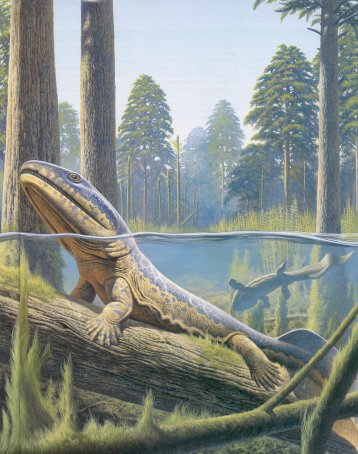[Recent Entries][Archive][Friends][User Info]
| Time | Text |
|---|---|
| 04:53 pm [Link] |
Acanthostega В девоне появляются первые амфибии. Акантостега (Acanthostega) — род ископаемых тетрапод, живших в позднем девоне и являющихся промежуточным звеном между лопастепёрыми рыбами и наземными животными. Одни из первых хордовых, развивших конечности. Окаменевший череп акантостеги (Acanthostega gunneri) был обнаружен в восточной Гренландии в 1933 году, однако описан лишь в 1952 году Эриком Ярвиком. В 1987 году Дженифер Кларк были обнаружены новые фрагменты нескольких особей. Кости акантостеги были найдены в древних речных отложениях, предполагается что именно в реках эти животные и обитали. Акантостега достигала длины около 60 см. Конечности не имели запястий, что говорит о крайне низкой приспособленности к передвижению по суше, и на каждой из них насчитывалось 8 пальцев. Строение скелета указывает на наличие внутренних жабр. Слабые конечности, которые не смогли бы выдержать вес животного, и короткие рёбра, на которые оно также не могло опираться, говорят о его преимущественно водном образе жизни. Acanthostega had eight digits on each hand (the number of digits on the feet is unclear) linked by webbing, it lacked wrists, and was generally poorly adapted to come onto land. Acanthostega also had a remarkably fish-like shoulder and forelimb. The front foot of Acanthostega could not bend forward at the elbow, and thus could not be brought into a weight bearing position, appearing to be more suitable for paddling or for holding on to aquatic plants. It had lungs, but its ribs were too short to give support to its chest cavity out of water, and it also had gills which were internal and covered like those of fish, not external and naked like those of some modern amphibians which are almost wholly aquatic. Acanthostega is the first tetrapod to show the shift in locomotory dominance from the pectoral to pelvic girdle. There are many morphological changes that allowed the pelvic girdle of Acanthostega to become a weight-bearing structure. In more ancestral states the two sides of the girdle were not attached. In Acanthostega there in contact between the two dies and fusion of the girdle with the sacral rib of the vertebral column. These fusions would have made the pelvic region more powerful and equipped to counter the force of gravity when not supported by the buoyancy of and aquatic environment. Research based on analysis of the suture morphology in its skull indicates that the species may have bitten directly on prey at or near the water's edge. Markey and Marshall compared the skull with the skulls of fish, which use suction feeding as the primary method of prey capture, and creatures known to have used the direct biting on prey typical of terrestrial animals. Their results indicate that Acanthostega was adapted for what they call terrestrial-style feeding, strongly supporting the hypothesis that the terrestrial mode of feeding first emerged in aquatic animals. If correct, this shows an animal specialized for hunting and living in shallow waters in the line between land and water. Newer research also indicates that it is possible Acanthostega actually evolved from an ancestro that was more terrestrail adapted than itself. Acanthostega is seen as part of widespread speciation in the late Devonian period, starting with purely aquatic lobe-finned fish, with their successors showing increased air-breathing capability and related adaptions to the jaws and gills, as well as more muscular neck allowing freer movement of the head than fish have, and use of the fins to raise the body of the fish. These features are displayed by the earlier Tiktaalik, which like the Ichthyostega living around the same time as Acanthostega showed signs of greater abilities to move around on land, but is thought to have been primarily aquatic.
Репродукции (1, 2, 3, 4, 5, 6):
Ископаемые останки (1, 2, 3, 4, 5, 6):
|
| Reply: | |






